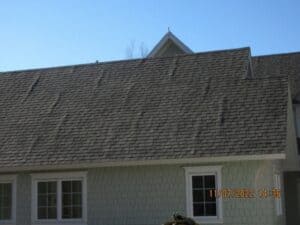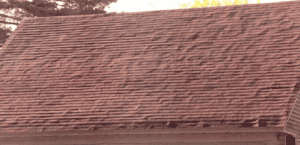Description
Buckling of asphalt shingles can occur in new roofs or reroofing, and is most often the result of wrinkles in the roofing underlayment or movement of the wood decking.
Moisture-induced deck effects typically show a pattern of shingle distortions coincidental with joints in the roof deck panels/lumber.
Possible Causes Include:
- Exposure of the wood roof deck panels to rain or dew during new construction or roof replacement can lead to the wood absorbing moisture. As moisture content increases in the wood, movement of the decking can occur.1
- Shingle installation onto dimensional lumber (aka board or plank decks) may lead to buckling due to differential expansion or contraction of individual/adjacent boards as their moisture content varies. Lack of proper ventilation of the attic space, which restricts the free flow of air directly beneath the roof deck, can create problems with moisture and temperature management in the attic space, contributing to wood deck movement.
- Roof deck joints should be staggered to minimize the effect of normal deck movement. Roof decking not spaced a minimum of 1/8” apart can lead to buckling due to expansion from moisture.
- Uneven decking, whether boards or panels, unrelated to structural movement may result in uneven/buckled shingles.
- As a new roof is installed, moisture can be trapped within the roofing system, and the underlayment may absorb moisture and wrinkle. Shingle buckling distortions due to wrinkled underlayment will be random throughout the roof area and not coincidental with joints in the roof deck.
- In some cases, there may be abnormal deck movement, unrelated to moisture issues, due to either structural deficiencies in the home’s/building’s construction or seismic/foundation effects.
- The resulting distortions are generally catastrophic and result in an obvious large roof system disruption.
- Shingles may exhibit an apparent “buckling-like” distorted appearance due to other factors, such as nails not driven flush with the shingle surface, shingles deformed prior to installation due to poor storage conditions, or foreign material under the shingles. These isolated distortions are usually randomly located on the roof and have very specific causes and, therefore, very specific remediations.
Prevention/Correction
- Whether new construction or re-roofing, ensure the space beneath the roof deck is properly ventilated according to applicable minimum building code requirements and shingle manufacturer’s recommendations. See ARMA’s additional resources regarding achieving proper ventilation2. Proper ventilation will minimize moisture ingress into deck materials and therefore minimize potential moisture-induced deck distortions.
- For new construction, use and install deck materials in compliance with applicable minimum building code requirements and shingle manufacturer’s instructions. Ensure the deck installation results in a smooth and even surface. Avoid exposing deck materials to excessive moisture prior to shingle installation. Additional information can be found in “How to Minimize Buckling of Asphalt Shingles,” published by APA – The Engineered Wood Association.
- Install underlayments/membranes (ASTM D226, ASTM D4869, ASTM D6757, ASTM D1970, or CSA A123.3) according to the underlayment and shingle manufacturer’s requirements. Avoid exposing roof underlayments to excessive moisture prior to shingle installation.
- Install the shingles as soon as practical after underlayment installation, according to the shingle manufacturer’s requirements. It is particularly relevant that nails are the correct length, fully driven, and flush without cutting into the shingle surface.
- If the above procedures have been followed and shingles still buckle, the roof system should be professionally evaluated to check for the root cause (such as, but not limited to, building structural issues, fasteners backing out of the deck, or foreign material beneath the shingles).
- After the existing shingles have been removed and the root cause of the shingle buckling has been remediated, either the existing shingles should be re-installed flat or, if the existing shingles have been compromised, new shingles should be installed. In cases of wrinkled/buckled underlayment, consult the manufacturer or contractor for recommended underlayment repair procedures.
Examples of buckled shingles are shown in the photos below:
Photo 1:

(Courtesy of CertainTeed)
Photo 2:

(Courtesy of GAF)
Industry experience indicates shingle buckling can be minimized if the following procedures are followed:
1 For additional information on roof deck materials and deck preparation see the ARMA Residential Asphalt Roofing Manual – Design and Application Methods.
2 For additional information regarding ventilation, see the ARMA Residential Asphalt Roofing Manual – Design and Application Methods, ARMA’s “Why Ventilation Is Important” Technical Bulletin, and ARMA’s “Considerations in Attic Ventilation System Selection” Technical Bulletin.
DISCLAIMER OF LIABILITY: This document was prepared by the Asphalt Roofing Manufacturers Association and is disseminated for informational purposes only. Nothing contained herein is intended to revoke or change the requirements or specifications of the individual roofing material manufacturers or local, state and federal building officials that have jurisdiction in your area. Any question, or inquiry, as to the requirements or specifications of a manufacturer, should be directed to the roofing manufacturer concerned. THE USER IS RESPONSIBLE FOR ASSURING COMPLIANCE WITH ALL APPLICABLE LAWS AND REGULATIONS.
Nothing contained herein shall be interpreted as a warranty by ARMA, either express or implied, including but not limited to the implied warranties of merchantability, fitness for a particular purpose or non-infringement. IN NO EVENT SHALL ARMA BE LIABLE FOR ANY DAMAGES WHATSOEVER, including special, indirect, consequential or incidental damages or damages for loss of profits, revenue, use or data, whether claimed in contract, tort or otherwise. Where exclusion of implied warranties is not allowed, ARMA’s liability shall be limited to the minimum scope and period permitted by law.

